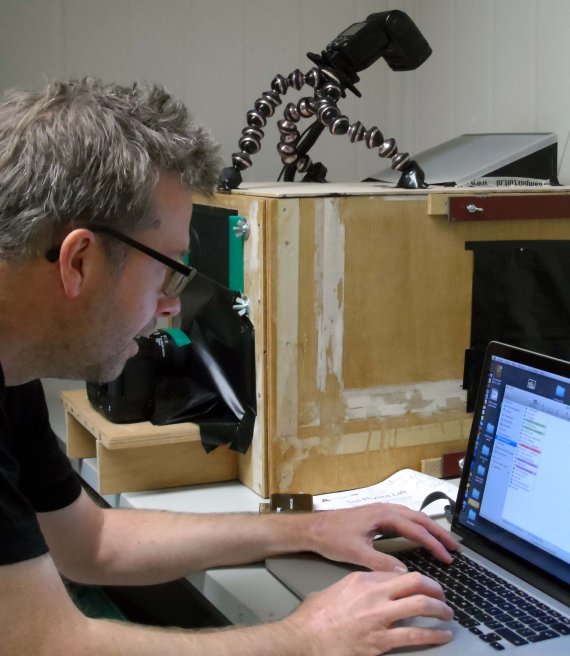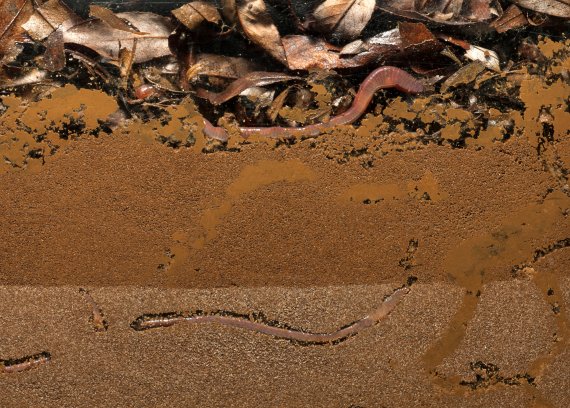Which is exactly what is going on in the cellar of the Atlas building on the Wageningen campus. In a corner of one of the labs stands what looks like a scruffy piece of craftwork. A wooden box with a camera stuck on to the front and a flashlight on a flexible tripod on top. DIY science? ‘I call it duct-tape technology, says photographer/ artist Wim van Egmond with a grin.
Because, make no mistake about it, behind that amateurish-looking piece of apparatus there lie high-tech and science. Van Egmond is a micro-photographer and well-known for his photos of life forms so small as to be invisible to the naked eye. Last year he won the international Nikon Small World prize with a photo of plankton (see www.micropolitan.org). What is standing in the cellar of Atlas is his latest project: wriggling worms.
Inside the wooden black box are earthworms. Every 15 minutes, Van Egmond’s camera takes an extremely sharp photo of a slice of earth about one centimeter thick, sandwiched between two glass plates. Above the ground there is a layer of autumnal leaves, while below ground worms of various kinds develop their infrastructure. When they are put together, the photos blend into a film about the invisible life of worms.
The technique is called time lapse, and is as old as film itself. As far as we know, however, it has never been used on worms wriggling around underground before, says soil ecologist Gerlinde de Deyn (Environmental Sciences, Soil Quality department). The worm project, an initiative of De Deyn’s together with colleagues Jan Willem van Groenigen and Ingrid Lubbers, got off the ground (or into it) with the help of a small grant from Brussels. The aim is to illustrate soil science in an up-to-date fashion.

The installation in the cellar at Atlas has already been producing a photo every quarter of an hour for a couple of weeks now. Van Egmond puts them together to make a film on his computer in a few hours. A week in the life of the worms reduced to 20 seconds. The experiment shows how quickly and where pairs of worms move around in an artificially formed soil that has coloured layers like a licorice allsort. The top layer of soil is farming soil, the lowest is fine sand. The layers in between are mixtures of the two in various proportions.
This is science, for De Deyn. She can gaze at the wriggling worms for hours. New details strike her all the time. Details of how they dig, of course. ‘But the growth of fungal threads is nice to see too. Earthworms love them. Here and there you see little dancing pinheads popping up, which are working on cleaning up the dead leaves in their own way.’ In the latest film you see two worms passing each other. One worm moves in a loop in order to come back to the same tunnel. Is this an alternative to backing?
The point is to make the invisible visible
Wim van Egmond
Van Egmond looks with an artist’s eye. This is new and unfamiliar territory for him. His usual habitat is that of the microscope. ‘I make portraits of microbes, with or without time-lapse technology. For me this is at a bit more of a distance from my usual work. But here too, the point is to make the invisible visible.’ And this is just the start; you never know where it will lead. Ideas for other experiments come up of their own accord.
De Deyn’s research focuses on interactions between roots and smaller soil organisms. Now that capturing worms on camera has been a success, she cannot wait to zoom in on the soil’s smaller fry. And what will happen if a plant is added to the system, for example? There are enough questions, but finding the answers costs money. De Deyn is working on ways to solve that one.
Here you can watch the film.

